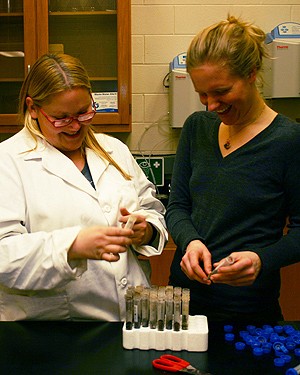
UC a Perfect Fit for Interdisciplinary Researcher
Amy Townsend-Small isnt your typical scientist. As an undergraduate at Skidmore College in upstate New York, she double-majored in English and biology, then went on to work at a publishing agency after graduation.
But after three years, she burnt out and turned to science to jumpstart her career.
This is going to sound funny but I just didnt want to have a job anymore, she says with a laugh. I wanted to go back to school because I just wanted to live a life of the mind.
So she applied to the PhD program at the University of Texas at Austin and spent five years taking classes and doing field research in marine science. Traipsing through the Peruvian Amazon River and Alaskas Kuparuk River for research data proved to be the perfect remedy for her 9 to 5 doldrums and she hasnt looked back.
Today she is an assistant professor at the University of Cincinnati with joint appointments in both the
and the
in the McMicken College of Arts and Sciences, while also teaching in the
.
The really cool thing about the College of Arts and Sciences is that we have an interdisciplinary research focus, Townsend-Small says. I was part of a joint hiring initiative along with professors in biology, chemistry, geography and geology, called the Geographic Information Networks (GINs) cluster. Our goal as a unit is to apply new technologies to environmental problems.
It works great for her, she says, because she doesnt have a strict background in geology or geographyher research has been interdisciplinary since she started graduate school.
My research is about how all the different sciences interact in the global cycle of elements, Townsend-Small says. I study biogeochemistry, which is how chemical elements that are important to life are cycled between living things and the rest of the Earth.
By studying elemental and isotopic signatures in marine, freshwater and terrestrial environments, she is hoping to gain understanding of human perturbations in both global and regional carbon and nitrogen cycles. During grad school at Texas, Townsend-Small spent her time focusing on river research, but when she started her postdoctoral fellowship at the University of California-Irvine, her focus shifted to urbanization and greenhouse gas emissions.
At UC, she hopes to continue both areas of research. And Cincinnati, as an urban environment with the Ohio River as a major water source to the Mississippi River and the Gulf of Mexico, offers Townsend-Small a serendipitous overlay in both areas of research.
Ohio is an interesting place to study rivers because were in the headwaters of the Mississippi. Because of places like Ohio, the Mississippi River is pretty polluted with nitrogen. Its a good fit for my interest in studying nitrogen.
It helps that other A&S faculty in the GINs cluster are interested in river experiments as well.
The new hires in A&S are all interested in all different kinds of research but the thing that really brings us all together is river research, Townsend-Small says. She and her other colleagues in geology have already planned to conduct research on the Great Miami River.
Its nice to find a university where people are accepting of my work. Not every place has a feeling for the importance of environmental and interdisciplinary research.
But for this publishing professional turned scientist, UC is a perfect fit.
Additional Contacts
M.B. Reilly | Executive Director, PR | Marketing + Communications
reillymb@ucmail.uc.edu | (513) 556-1824
Related Stories
UC’s spring Visiting Writers Series promises robust, diverse...
December 20, 2024
Lovers of literature, poetry and the written word can look forward to a rich series of visiting writer presentations, offered through UC’s College of Arts and Sciences department of English, coming this spring.
Should voters have more say in Ohio's Legislature?
December 19, 2024
UC Professor David Niven talks to WVXU about gerrymandering in Ohio.
How tadpoles make the leap to frogs
December 18, 2024
In his biology lab, UC Professor Daniel Buchholz and his students are using a National Science Foundation grant to study the hormones that trigger metamorphosis in frogs.
